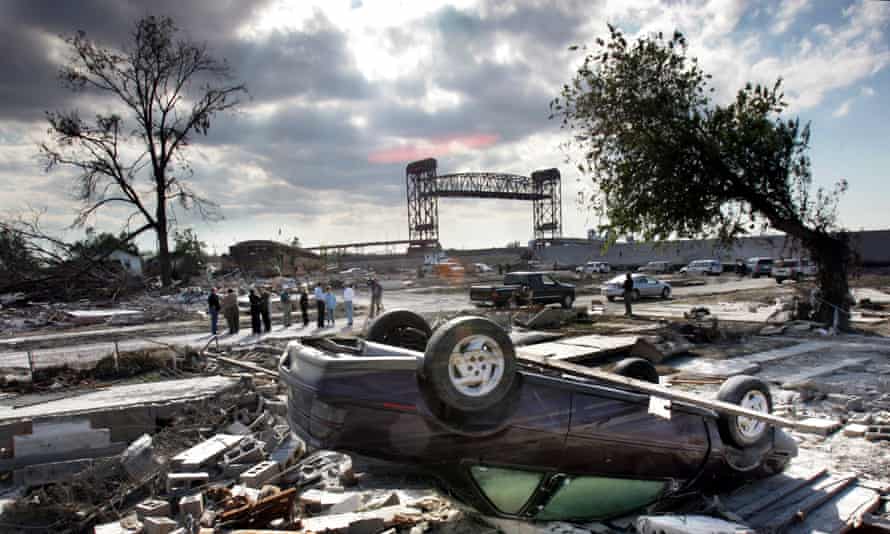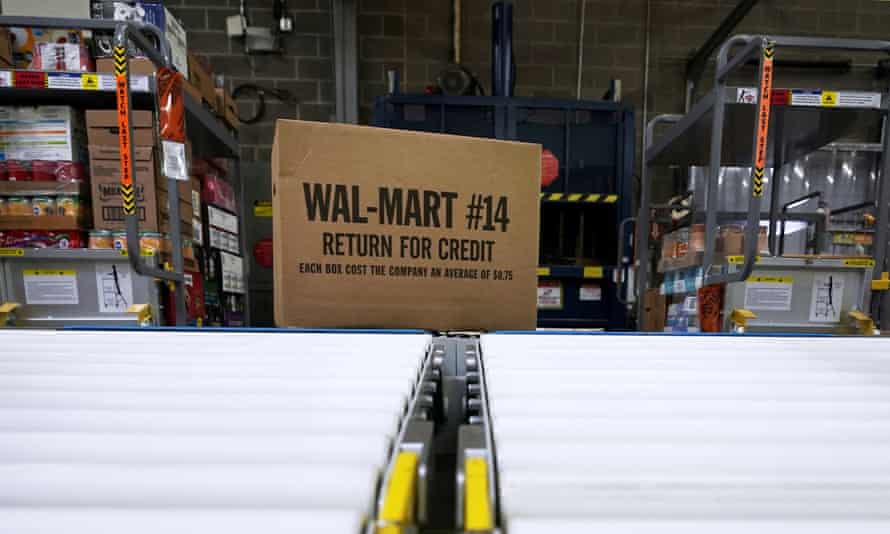Walmart has a plan to tackle the climate crisis. Can it pull it off?
Walmart is attempting to erase its huge climate footprint while continuing to sell tens of millions of low-priced products

Last modified on Mon 13 Sep 2021 15.05 EDT
Every day a seemingly never-ending stream of toothbrushes, toilet paper, tape, thumbtacks, toys and other products criss-cross the globe from a network of suppliers to Walmart’s more than 10,500 stores.
The retailer, which was for many years the biggest in the world until Amazon took its crown in August, has a supply chain almost unfathomably complex. And it comes with a huge carbon footprint. In 2019 the company emitted 17.56m metric tons of greenhouse gases.
Walmart has declared its mission to tackle these climate impacts, which means focusing on every part of the chain – from the electricity sourced in its stores to the palm oil in the candy bars sold on its shelves. But while some experts celebrate the scale of the retailer’s efforts, others wonder whether they go far enough.
Over the past years, Walmart has come out with a slew of climate promises. In 2017, it launched “Project Gigaton”, pledging to cut 1bn metric tons of carbon emissions from its supply chain by 2030. Last year it announced a goal to reach zero emissions from its global operations by 2040 without relying on carbon offsets – where companies “cancel out” some of their impact by funding projects that reduce carbon emissions. It’s also promised to be a 100% renewably-powered, zero waste and “regenerative” corporation that does more good than harm.
“It’s extraordinary,” said Michael Vandenbergh, co-director of the Climate Change Research Network at Vanderbilt Law School. “What we’re talking about is one of the largest and most conservative companies in the world making a range of commitments that government is not requiring them to make.”
Yet it’s an uphill task for a retail giant with a business model based on providing tens of millions of low-priced products to a growing number of customers. The big question will be whether this type of business model can persist in a way that aligns with climate science, said Simon Fischweicher, head of corporations and supply chains for environmental nonprofit CDP North America.
An epiphany
The devastation of Hurricane Katrina, which killed more than 1,800 people across the Gulf coast region in 2005, proved to be a moment of epiphany for Walmart’s then chief executive, Lee Scott.
In an October 2005 speech in Arkansas, he asked: “What if we used our size and resources to make this country and this Earth an even better place for all of us: customers, associates, our children, and generations unborn? What would that mean? Could we do it? Is this consistent with our business model?”

The company set about developing a sustainability plan. Some measures were relatively straightforward. In the early 2000s, for example, it found that reducing the size of packaging for a kid’s truck toy meant it needed fewer trucks on the road, saving $3.5m on transportation costs, while also using fewer resources.
But other early efforts fell flat. Walmart struggled to figure out how to highlight products’ sustainability credentials to customers and was accused of greenwashing for clumsy moves such as putting green labels on condensed soup cans for Earth Day.
It began to shift away from trying to communicate sustainability to consumers and towards focusing on encouraging suppliers to become more sustainable – the company’s supply chain is responsible for around 95% of its total emissions impact.
Walmart came out with goals to produce zero waste, use 100% renewable energy, and figure out what “sustainable” meant when it came to its products. It was the first retailer to have its emissions reduction target approved by the Science Based Targets initiative, which helps companies calculate targets in line with the aims of the Paris climate agreement.
And while many companies set targets decades away, some of Walmart’s most ambitious climate goals, including Project Gigaton, have deadlines within the next decade. This is an encouraging sign, Fischweicher said: “We cannot wait to set ambitious targets that are only going to be achieved between 2040 and 2050, that’ll be too late to make the changes we need.”
‘We don’t know exactly how we’ll get there yet’
According to Walmart’s July sustainability report, the company is about a third of the way to its goal, set in 2016, of reducing its absolute scope 1 emissions (those related to its operations) and scope 2 emissions (from the electricity it uses) by 35% by 2025.
The retailer has four years left to hit its target of powering 50% of its operations by renewable energy – 36% of its operations currently run on renewable energy. By 2035 it aims to reach 100%.
It might not be easy, said Fischweicher. “They face the challenges of dealing with the world today where the renewable market is growing, but is it enough to supply the 100% goal they set?” In some regions where Walmart operates, he said, the renewable energy market may not be developed enough to provide the amount needed.
The EPA’s Green Power Partnership rankings currently place Walmart as the fourth largest user of green power behind Google, Microsoft, and Intel. But while the three tech companies’ use of renewables represents between 93% and 100% of their total electricity in the US, for Walmart it’s 14%.
Walmart’s head of sustainability Kathleen McLaughlin said she’s confident that the company can make its renewable goals, pointing to several renewable energy projects in their pipeline.
Walmart’s zero emissions goal is likely to be tougher. “We don’t know exactly how we’ll get there yet,” McLaughlin said. Long haul trucking is one of the biggest hurdles, she said, as it relies on electric truck technology as well as a more comprehensive nation-wide charging system.
“There’s no solution today, but we believe there should be one,” said McLaughlin. “It should be possible to get to a zero emissions long-haul fleet by 2040. Our philosophy was, ‘What we think is possible, we’ve got to go for.'”

But some criticize Walmart’s zero emissions goal for not including the company’s supply chain, which accounts for the vast majority of Walmart’s overall climate impact. “Without that, drastic emissions reduction will never happen,” said Souparna Lahiri, co-author of a report on net zero by Corporate Accountability.
McLaughlin said that Walmart’s zero emissions goal combined with Project Gigaton, to which more than 3,100 suppliers have signed up, is in line with what the company needs to contribute to the a collective goal of net zero emissions by 2050.
Both Hyatt and Fischweicher said Walmart has been consistent in considering its supply chain. It’s one of the few companies that asks its suppliers to disclose information about their impact on deforestation, said Fischweicher, which can be “immensely powerful when you think about the palm oil, timber, cattle, soy, that end up in the products on Walmart’s shelves.”
However, the company still faces serious questions about its impacts. A February investigation by the Guardian found that Walmart along, with other big retailers, was selling beef linked to deforestation in Brazil’s Amazon forest – a difficult revelation for a corporation that had just announced months prior it aimed to become a”regenerative” company committed to sourcing sustainable products and encouraging better agriculture practices.
Responding at the time, Walmart said it takes the “allegations seriously and will review the claims made”. A spokesperson told the Guardian that the retailer aims to source 100% deforestation free beef, engaging with suppliers as well as using aerial verification tools to meet this goal.
Retail role model?
Perhaps one of the most powerful impacts multinational companies like Walmart can have is to influence and shift the actions of others: industry, consumers and government.
“Anything that Walmart does drags the rest of the retailers along,” said David Hyatt, a professor at the University of Arkansas and co-author of a study on Walmart’s sustainability efforts
With thousands of suppliers around the globe, Walmart has the potential to “reach across international boundaries,” said Vandenbergh, and push companies to act on environmental issues, bypassing the sometimes grinding slowness of political action.
With data suggesting Walmart is more popular among Republicans, it could also help shift attitudes on climate action, Vandenbergh said. Last December, Walmart was among 42 corporations that signed a letter to Joe Biden urging the new administration to rejoin the Paris climate agreement and adopt ambitious climate policies.
“Walmart is not seen by much of the American public as a large, liberal company,” Vandenbergh said. “This makes it harder for those on the right to dismiss [climate action] if Walmart is doing it.”
Some hope this could trickle into political action. Corporate achievements can help “smooth the way for regulatory reform,” said Zdravka Tzankova, an associate professor of sociology at Vanderbilt University, “because the public policy will already be reiterating what’s being achieved in the market.”
Tzankova cites the example of retailers, including Walmart, who worked with the Environmental Defense Fund to ban certain toxins from consumer products, including triclosan in clothing and toys and parabens used in cosmetics. These companies were a critical lever, she said, in helping pressure the US government to strengthen the Toxic Substances Control Act in 2016.
Buying time
Navigating the inherent difficulties of reconciling its sustainability aims with a business model based on providing increasing amounts of low-priced products to a growing customer base is a challenge Walmart can’t escape and it’s one McLaughlin acknowledges.
The goal, McLaughlin said, is to decouple growth from impact. Currently, Walmart has a slew of zero waste to landfill and recyclable packaging goals.
To address its entire impact, however, the company will also have to consider how customers use and dispose of products. Walmart will have to pay “a lot more attention” to all the products sold, the products’ lifecycle, “and how they influence consumer behavior”, said Fischweicher.
Only 8.6% of the global economy is currently considered “circular” at the moment – meaning materials are reused rather than sent to landfill or incinerated – according to a 2021 report by consultancy EY.
This challenge of erasing its huge footprint is bigger than Walmart alone and requires systemic action, especially at government level, but corporate climate action can help “buy time”, said Vandenbergh. “By using the tools in front of us to achieve massive reductions in greenhouse gas emissions,” he said, “that gives us the ability to think more long-term about how to create a society that is decarbonized.”
“There are a lot of problems with the corporate capitalism model,” said Tzankova, “but before we reinvent that, I find it hard to hammer on Walmart.”
